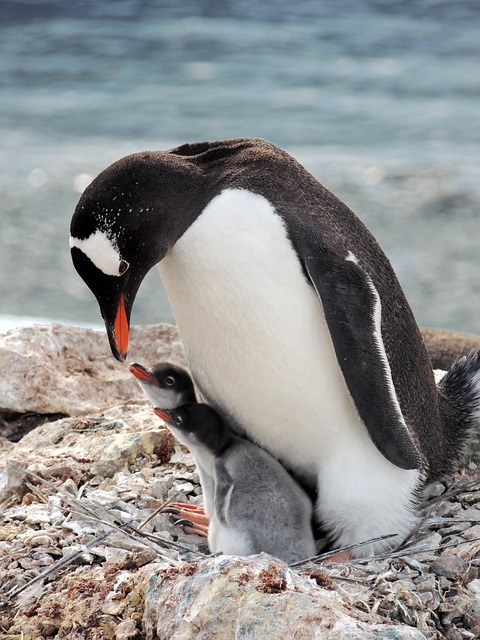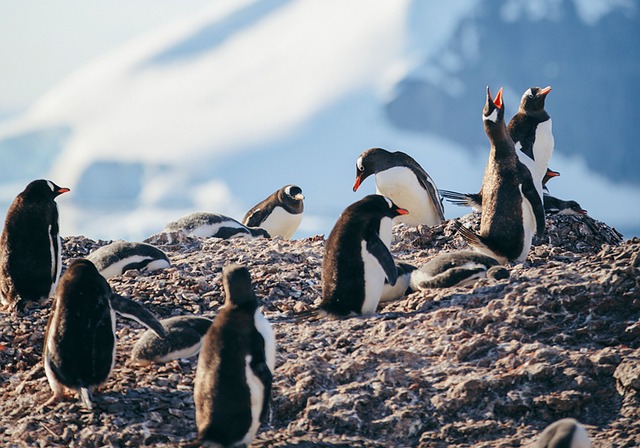Here are 50 interesting facts about Gentoo penguins
Scientific Name: The scientific name for the Gentoo penguin is Pygoscelis papua.
Size: Gentoo penguins are the third-largest penguin species, with an average height of about 20 to 35 inches (51 to 89 cm).
Weight: They typically weigh between 8 to 14 pounds (3.6 to 6.3 kilograms).
Plumage: Gentoo penguins have a distinctive appearance with a white belly, black back, and a wide white stripe extending across the top of their head and down their neck.
Bill Color: Their bills are orange-red and stand out against their black and white plumage.

Habitat: They are found on various subantarctic and Antarctic islands, as well as the Antarctic Peninsula.
Range: Gentoo penguins have a broad range that includes the Falkland Islands, South Georgia, South Shetland Islands, and several other locations.
Climate: They are well-adapted to cold, polar climates, often enduring freezing temperatures and icy waters.
Feeding Habits: Gentoo penguins primarily feed on krill, but their diet also includes fish and other small marine creatures.
Diving Abilities: They are excellent divers, capable of diving to depths of up to 656 feet (200 meters) in search of food.
Speedy Swimmers: Gentoo penguins can swim at speeds of up to 22 miles per hour (35 kilometers per hour).
Communication: They communicate with each other using vocalizations such as trumpeting and braying calls.
Colony Size: Gentoo penguin colonies can vary in size from a few pairs to thousands of individuals.
Lifespan: In the wild, they can live up to 15 to 20 years, although many do not reach old age due to predation and environmental factors.
Breeding Season: The breeding season for Gentoo penguins typically begins in September and lasts through November.
Nesting Habits: They build nests using pebbles and other materials, often in sheltered locations near the coast.
Eggs: Gentoo penguins usually lay two eggs, but only one chick usually survives to fledge.
Incubation: Both parents take turns incubating the eggs and guarding the nest.
Parental Care: After hatching, chicks are fed by both parents, who regurgitate krill and fish for their young.

Chick Development: Gentoo penguin chicks fledge and become independent after about 75 to 90 days.
Molting: Gentoo penguins undergo an annual molt, during which they replace old feathers with new ones.
Color Changes: During the molting process, their plumage appears duller and more grayish.
Swimming Adaptations: Gentoo penguins have flipper-like wings and webbed feet, well-suited for swimming.
Monogamous Pairs: They often form monogamous pairs, and mates may stay together for several breeding seasons.
Courtship Displays: During courtship, they engage in displays like head-turning and mutual preening.
Predators: Natural predators of Gentoo penguins include leopard seals, orcas, and various seabirds.
Whisker-Like Feathers: They have fine, whisker-like feathers around their eyes and bill that help protect their eyes from the sun’s glare.
Nesting Material: Gentoo penguins use pebbles and rocks to build their nests, with some individuals known to “steal” pebbles from neighboring nests.
Social Birds: They are social animals and often gather in groups both on land and at sea.
Flippers and Webbed Feet: Their flipper-like wings and webbed feet make them agile swimmers.
Antarctic Residents: Gentoo penguins are one of the few penguin species that are year-round residents of the Antarctic region.
Climate Adaptations: They have adapted to cold temperatures by developing a layer of insulating blubber.
Diving Duration: Gentoo penguins can stay submerged for up to 7 minutes during dives.
Human Interaction: They are often observed by tourists visiting subantarctic and Antarctic regions.
Minimal Sexual Dimorphism: Males and females of the species have similar plumage and are challenging to distinguish visually.
Warmth in Numbers: They huddle together in large colonies to conserve heat during cold nights.
Courtship Gifts: Male Gentoo penguins may offer pebbles to females as part of their courtship displays.
Preening Behavior: Mutual preening is common among Gentoo penguin pairs and reinforces their bonds.
Vocal Repertoire: They produce a variety of vocalizations for communication, including trumpeting, braying, and honking.
Large Colonies: Some Gentoo penguin colonies can contain thousands of breeding pairs.
Food Storage: They have a specialized stomach that can store food for later digestion.
Adaptation to Harsh Conditions: Their waterproof feathers and blubber layer help them withstand the icy waters of the Southern Ocean.
Nesting Competitors: Gentoo penguins may compete for nesting sites with other bird species such as skuas and giant petrels.
Swimming Techniques: They use their flippers and feet to propel themselves through the water.

Communal Nesting: Gentoo penguins often nest in close proximity to each other, creating a communal nesting environment.
Estimation of Colony Size: Researchers often estimate the size of Gentoo penguin colonies using aerial surveys.
Population Monitoring: Conservationists closely monitor Gentoo penguin populations to assess their health and the impact of environmental changes.
Conservation Initiatives: Various efforts are in place to protect the Antarctic and subantarctic regions where Gentoo penguins reside.
Subspecies: There are several subspecies of Gentoo penguins found in different geographic regions.
Ecological Role: Gentoo penguins play a vital role in the Antarctic food web by consuming krill and fish, thereby helping to regulate these populations.
Gentoo penguins are captivating birds with unique adaptations and behaviors that make them a subject of interest for researchers and wildlife enthusiasts. Their ability to thrive in some of the harshest environments on Earth is a testament to their resilience and adaptability.
